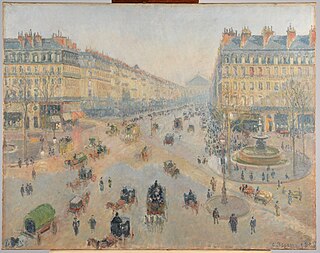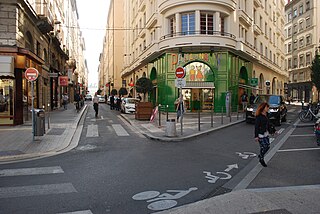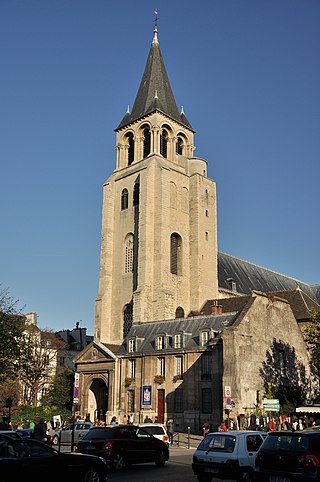
The 15th arrondissement of Paris is one of the 20 arrondissements of the capital city of France. In spoken French, it is referred to as le quinzième.

La Motte-Picquet–Grenelle is a station of the Paris Métro, at the interconnection of line 6, line 8, and line 10 in the 15th arrondissement. The station combines underground and elevated platforms. It is a major métro interchange on the Rive Gauche, the biggest west of Montparnasse.

Félix Faure is a station on line 8 of the Paris Métro in the 15th arrondissement. It is named after the nearby avenue Félix-Faure, which is in turn named after Félix Faure (1841–1899), the President of France from 1895 to 1899. It is the first of three stations on the network that were named after a President of France; the other two being Charles de Gaulle–Étoile on lines 1, 2, and 6, and Bibliothèque François Mitterrand on line 14.

Commerce station is a station on line 8 of the Paris Métro in the Rue du Commerce, at the intersection with the Place du Commerce in the 15th arrondissement.

Avenue Émile Zola is a station on line 10 of the Paris Métro. Located in the 15th arrondissement, it is situated at the eastern end of avenue Émile Zola, at the intersection of the rue du Commerce and rue Fondary. The station is named after the nearby avenue Émile Zola, which in turn is named after Émile Zola (1840-1902), a prolific French writer during the 19th century.

Grenelle is a neighbourhood in southwestern Paris, France. It is a part of the 15th arrondissement of the city.

Wallace fountains are public drinking fountains named after, financed by and roughly designed by Sir Richard Wallace. The final design and sculpture is by Wallace's friend Charles-Auguste Lebourg. They are large cast-iron sculptures scattered throughout the city of Paris, France, mainly along the most-frequented sidewalks. A great aesthetic success, they are recognized worldwide as one of the symbols of Paris. A Wallace fountain can be seen outside the Wallace Collection in London, the gallery that houses the works of art collected by Sir Richard Wallace and the first four Marquesses of Hertford.

Haussmann's renovation of Paris was a vast public works programme commissioned by French Emperor Napoleon III and directed by his prefect of the Seine, Georges-Eugène Haussmann, between 1853 and 1870. It included the demolition of medieval neighbourhoods that were deemed overcrowded and unhealthy by officials at the time, the building of wide avenues, new parks and squares, the annexation of the suburbs surrounding Paris, and the construction of new sewers, fountains and aqueducts. Haussmann's work was met with fierce opposition, and he was dismissed by Napoleon III in 1870. Work on his projects continued until 1927. The street plan and distinctive appearance of the centre of Paris today are largely the result of Haussmann's renovation.

Javel–André Citroën is a station of the Paris Métro, serving line 10 and offering transfer to the RER C via Javel RER station in the 15th arrondissement. West of this station, line 10 splits into separate eastbound and westbound sections until Boulogne–Jean Jaurès.

The quartier du Petit-Montrouge is number 55 of the 80 quartiers administratifs in Paris. It lies in the 14th Arrondissement, in the south of the capital. It owes its name to the adjacent commune of Montrouge, of which it formed a part before 1860. It is familiar as the quartier Alésia, from the name of a street that bisects it and from the principal Métro station that serves it, although the quartier Alésia does not exactly overlap the quartier du Petit-Montrouge.

The Louvre Saint-Honoré building is a historic structure in Paris, occupying an entire urban block between the rue de Rivoli, the place du Palais-Royal, the rue Saint-Honoré, and the rue de Marengo, with a total floor surface of 47,000 square meters. It was originally erected in the early 1850s by the Pereire brothers who in 1855 opened an iconic hotel, the Grand Hôtel du Louvre, and an innovative street-level department store, branded from 1863 the Grands Magasins du Louvre. While the Grand Hôtel closed in 1887, the Grands Magasins expanded and kept operating in the building until 1974. From 1978 to 2016 they were succeeded by a specialized mall of antiques shops, the Louvre des Antiquaires, while the upper floors were repurposed as rented office space. Since 2020, the building's lower levels have been undergoing conversion to become the new flagship home of the Fondation Cartier pour l'Art Contemporain.

Jules Aimé Lavirotte was a French architect who is best known for the Art Nouveau buildings he created in the 7th arrondissement in Paris. His buildings were known for his imaginative and exuberant decoration, and particularly for his use of sculpture and glazed ceramic tiles on the facades, made in collaboration with leading sculptors and the ceramic manufacturer Alexandre Bigot. He was three times awarded prizes by the city of Paris for the most original facades, for the Lavirotte Building at 29 Avenue Rapp (1901), for the Ceramic hotel, 34 Avenue de Wagram (1904), and for the building at 23 avenue de Messine in 1907.

The Rue de la République is a street located in the 1st and 2nd arrondissements of Lyon, France. It links the Place de la Comédie in the north to Place Le Viste in the south, just next to Place Bellecour, via the Place de la République.

The Rue Émile-Zola is a street located in the 2nd arrondissement of Lyon, near Place Bellecour. This is one of the busiest shopping streets of Lyon, which was described as a "bourgeois" street because there are many upscale shops. It begins with the Place des Jacobins and ends at the Place Bellecour after crossing the rue des Archers, and belongs to the zone classified as World Heritage Site by UNESCO. It was named as tribute to the writer of the same name.

The Rue Nationale is one of the oldest streets and the busiest shopping street in the city of Tours.

The Rue Saint-Lazare is a street in the 8th and 9th arrondissements of Paris, France. It starts at 9 Rue Bourdaloue and 1 Rue Notre-Dame-de-Lorette, and ends at Place Gabriel-Péri and Rue de Rome.

The city of Paris has notable examples of architecture of every period, from the Middle Ages to the 21st century. It was the birthplace of the Gothic style, and has important monuments of the French Renaissance, Classical revival, the Flamboyant style of the reign of Napoleon III, the Belle Époque, and the Art Nouveau style. The great Exposition Universelle (1889) and 1900 added Paris landmarks, including the Eiffel Tower and Grand Palais. In the 20th century, the Art Deco style of architecture first appeared in Paris, and Paris architects also influenced the postmodern architecture of the second half of the century.

The Rue des Entrepreneurs in Paris, France, is a street located in the Paris 15th arrondissement. It runs from the Avenue Émile Zola to the Rue de la Croix Nivert. It is about 800 metres long and 14 metres wide. Its name comes from the 19th-century entrepreneurs who owned land nearby, after its creation in 1851.
The concours de façades de la ville de Paris was an architecture competition organized by the city of Paris at the very end of the 19th century and beginning of the 20th century.

The Avenue de Suffren is an avenue situated between the 7th and 15th arrondissements of Paris. It is named for the 18th-century admiral Pierre André de Suffren.





















